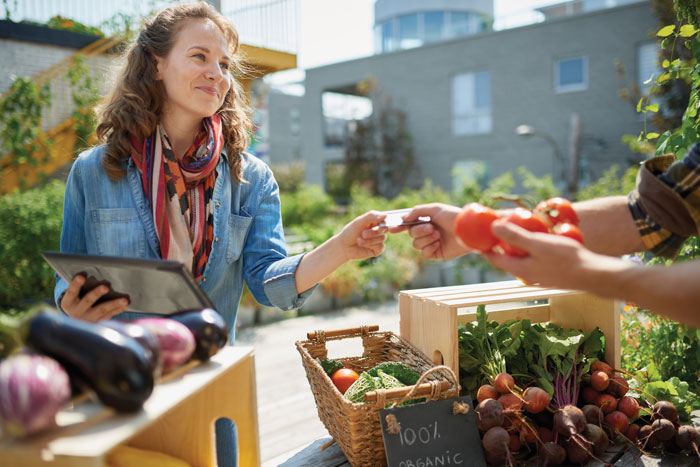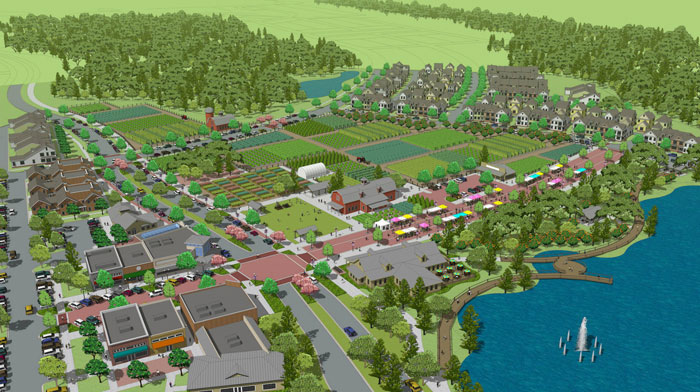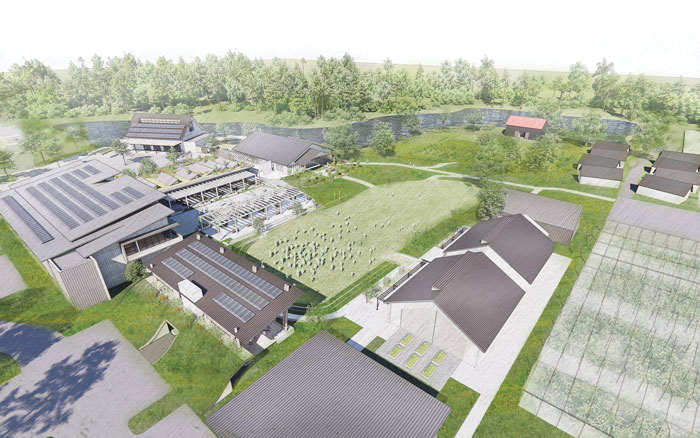
Agrihoods are somewhat new on the development landscape. In fact, they were unheard of even a decade ago. Today, throughout the U.S. and Canada, about 200 agrihoods are in various stages of construction or completion, research shows. There are two new agrihoods underway in the Orlando area.
GREEN ACRES
Country tunes wafted and Tampa Bay Bucs flags flapped as Bill and Rebecca Hurst wheeled their gas-engine golf cart to one of their favorite neighborhood spots — the community garden in Winter Garden’s Oakland Park.
Once considered a grandmotherly throwback, vegetable gardens now attract the cool crowd and have come to define several high-profile communities taking shape in Central Florida.
“It tastes better when it comes from your own farm,” says Hurst, who grew up on a farm in Kentucky. Among other things, the Hursts’ three children have immersed themselves in plant science and the satisfaction of growing their own food.
Developers have turned to garden- and farm-based “agrihood” communities as a way to source local food, promote health and engage families like the Hursts.
Agrihoods are somewhat new on the development landscape. In fact, they were unheard of even a decade ago. Today, throughout the U.S. and Canada, about 200 agrihoods are in various stages of construction or completion, research shows.
In addition to converting suburbanites into gardeners, the agri-neighborhoods have been hailed as a way to preserve slivers of fast-disappearing farmland and make farming accessible to everyone who has a bit of Oliver Wendell Douglas in their souls.
In Florida, the Pine Dove Farm in Tallahassee launched about three years ago with community gardens, a small farm and Florida vernacular homes all intertwined on 203 acres. Near Palm Beach in Wellington, Arden came online about two years ago with an urban-style farm among its thousands of acres.
In Central Florida, the agrihood concept is in its infancy and doesn’t yet have the wide appeal that community golf courses once did. But the marriage of crops and residential development is emerging quickly in a region that has long traded agricultural lands for homes and highways.
“I think people like walking to the farmers’ market. People like being outdoors,” says Brock Fanning, who oversees the Orlando division of Toll Brothers, which is building townhomes in The Packing District, an emerging College Park agrihood.
The Hurst’s Oakland Park neighborhood and several other Orlando-area communities have dabbled with raised garden plots or even occasional shared community gardens, such as Osceola County’s Harmony. And backyard gardens have increasingly sprouted up in yards near downtown Orlando and other parts of the region.
Fleet Farming, a nonprofit founded by Orlando-based IDEAS for Us and the state’s Cooperative Extension Service, has helped amateur gardeners cultivate rows of bib lettuce, stalks of sweet corn and heritage tomatoes in plots reminiscent of the Victory Gardens that spawned more than a third of the country’s vegetables during World War II.
In the Audubon Park area east of downtown Orlando, for instance, Fleet Farming has transformed more than a dozen lawns into productive gardens managed by the nonprofit, which does the cultivating and harvesting. The group also has helped hundreds of other home gardeners locally.
Now, the budding trend is about to take root in the heart of Florida’s old orange-grove culture. Two new Central Florida residential communities have defined themselves with professionally managed, working farms — The Grow in east Orange County, near Lake Pickett Road and State Road 50, and the College Park’s Packing District.
Famed beef brisket is the secret behind farm operations in the Packing District’s 200-acre residential and commercial project in Orlando’s College Park area. The charitable arm of the 4 Rivers Smokehouse restaurant chain, founded by John Rivers, is bringing an educational farming campus to life there.
Almost half The Packing District will be residential, restaurants, shops and offices. The other half will be park space, and there’ll be as many as 3,500 townhomes, apartments and duplexes on the site.
The residential mix will include Toll Brothers’ 8-acre townhome neighborhood, The Brix. The name stems from a measurement that helps determine the peak ripeness of fruit and is a nod to the citrus legacy of the Dr. P. Phillips Foundation, says Toll’s Brock Fanning.
The builder expects to roll out the first of its 135 three-story townhomes in August or September. Featuring optional rooftop terraces, the brick-clad architecture is described as “urban, transitional, and industrial-inspired.” Floorplans range in size from 1,388 to 1,975 square feet and are priced starting in the mid-$300s.
The farm campus is the district’s signature tract. Situated on property leased to the 4R Foundation by the City of Orlando, the farming operation will help feed disadvantaged families. It’s also expected to engage residents with opportunities to volunteer and purchase produce.
“In looking at The Packing District and the things that would benefit all of Central Florida, we felt an urban farm was a critical part of what we wanted to do,” says Kenneth Robinson, president of the Dr. P. Phillips Foundation, which has worked with the city on the undertaking.
Without any real examples nearby of what they had in mind, the foundation searched for a community farm model and found the Stone Barns Center for Food & Agriculture in Tarrytown, New York.
In addition to providing food to local residents and restaurants, the center partners with farmers on innovative farming techniques. Packing District backers toured Stone Barns and came back with more than just ideas. They also found a director. Sara Elliott has relocated from New York and now serves as director of the 4Roots Farm Campus.
“Food kind of touches everything in our lives — and more and more people are craving that connection of back-to-nature through the food they eat,” Elliott says. “This will definitely be a place where they can have that experience.”
With a million-dollar boost from the Dr. Phillips organization, the farm campus will feature a professionally operated farm, discovery center, event barn, teaching/demo kitchen, farm-to-table restaurant and farmers’ markets.

The Grow
When developer Dwight Saathoff began crafting a new megaproject centered on the idea of urban farming, he considered details like cucumber beetles and pickleworms.
“Community gardens are going to be difficult when the homeowner takes care of their particular plot,” says Saathoff, president of the Orlando-based Project Finance and Development Group. “In Florida, you have to have those plants nearby and visit daily.”
Ah yes, convenience.
Without proximity between people and their plants, pests such as pickleworms can multiply on the undersides of succulent leaves while unsuspecting gardeners enjoy adult beverages and binge on Netflix from the comfort of their homes a few blocks away. Shared, remote garden spaces can also spark conflicts with pesticide chemicals drifting onto unwanted places.
To balance the ceaseless demands of vegetable gardens with the ability to access them easily, Saathoff took a multi-pronged approach for The Grow.
On track to be the largest agrihood in the region, the 1,200-acre community is slated for construction to begin in less than a year. As planned, thousands of old-Florida-style homes will wrap around parks along with vintage-style retail and a 9-acre farm managed by professional farmers. Split rail fences and a windmill will add to the ambiance.
Twenty-three acres of community gardens will be spread throughout The Grow, with two of the larger gardens tended by professional farmers. The remainder will be populated with lower-maintenance plants such as blueberries, papayas, fig trees and citrus.
The professional farmers will serve as “farm ambassadors” to advise homeowners with at-home garden installations about growing seasons, potted herb gardens and more. Saathoff says assistance from the neighborhood experts will encourage gardens that are “less intimidating and more likely to succeed.”
Adding a professionally managed farm to a neighborhood is similar to adding amenities such as a clubhouse or pool, adds Saathoff. Maintenance costs are, of course, greater for farms — but fruit and vegetable sales to the on-site restaurant and market can offset overhead.
Hosting weddings and other events at the community barn is also expected to boost finances “and the HOA will fill in the gap,” he notes.
Branded by the concept of agrihoods, The Grow’s estate lots are marketed as “farmettes” and span at least 150 feet.
Home prices are expected to range from $315,000 to $1.3 million, with varied materials and elevations that are reflective of the Florida farmhouse style.

The Packing District
Famed beef brisket is the secret behind farm operations in the Packing District’s 200-acre residential and commercial project in Orlando’s College Park area. The charitable arm of the 4 Rivers Smokehouse restaurant chain, founded by John Rivers, is bringing an educational farming campus to life there.
Almost half The Packing District will be residential, restaurants, shops and offices. The other half will be park space, and there’ll be as many as 3,500 townhomes, apartments and duplexes on the site.
The residential mix will include Toll Brothers’ 8-acre townhome neighborhood, The Brix. The name stems from a measurement that helps determine the peak ripeness of fruit and is a nod to the citrus legacy of the Dr. P. Phillips Foundation, says Toll’s Brock Fanning.
The builder expects to roll out the first of its 135 three-story townhomes in August or September. Featuring optional rooftop terraces, the brick-clad architecture is described as “urban, transitional, and industrial-inspired.” Floorplans range in size from 1,388 to 1,975 square feet and are priced starting in the mid-$300s.
The farm campus is the district’s signature tract. Situated on property leased to the 4R Foundation by the City of Orlando, the farming operation will help feed disadvantaged families. It’s also expected to engage residents with opportunities to volunteer and purchase produce.
“In looking at The Packing District and the things that would benefit all of Central Florida, we felt an urban farm was a critical part of what we wanted to do,” says Kenneth Robinson, president of the Dr. P. Phillips Foundation, which has worked with the city on the undertaking.
Without any real examples nearby of what they had in mind, the foundation searched for a community farm model and found the Stone Barns Center for Food & Agriculture in Tarrytown, New York.
In addition to providing food to local residents and restaurants, the center partners with farmers on innovative farming techniques. Packing District backers toured Stone Barns and came back with more than just ideas. They also found a director. Sara Elliott has relocated from New York and now serves as director of the 4Roots Farm Campus.
“Food kind of touches everything in our lives — and more and more people are craving that connection of back-to-nature through the food they eat,” Elliott says. “This will definitely be a place where they can have that experience.”
With a million-dollar boost from the Dr. Phillips organization, the farm campus will feature a professionally operated farm, discovery center, event barn, teaching/demo kitchen, farm-to-table restaurant and farmers’ markets.
Challenges
Like any new endeavor, blending snap beans and watermelon with community mailboxes and parks could face some growing pains
Liz Felter, a regional specialized agent for the Florida extension services, says she has worked with several developers considering agrihoods in Central Florida.
“I think honestly, when they come to us for information and fact finding, they’re overwhelmed when they realize what they don’t know,” Felter says. “It’s a lot harder work and has a lot more science than you might imagine.”
Insects, nematodes, freezes and shortages of farmhands are just a few of the stressors. In addition, homeowners’ associations may tire of subsidizing operations.
“Community gardens are nice and great, and I love the fact that we have people who want to do it,” adds Felter, who has a doctorate in agricultural education and communication from the University of Florida. “They’re in love with the romance of doing it but they don’t want to do the work.”
The reality is, this new brand of development may replace pastures, groves, hammocks and prairie. That’s why Caroline Chomanics, chief operations officer with Fleet Farming, cautions homebuyers from embracing gardening at the expense of nature.
She says she supports people growing their own food but prefers gardening in established areas instead of developing ones. “There’s a fine line between being environmentally responsible and “greenwashing,” which is trying to make something look environmental or sustainable when it perhaps cut down a beautiful pristine forest,” she notes.
Even the fundamental element of homebuyers’ appetite for agrihoods remains to be seen. How much will they pay to be part of the experience? How much will they participate and support it?
Even though the sweet taste of bib lettuce freshly plucked from the garden is undeniable, less than half of agrihood residents surveyed shopped in their neighborhood market during the course of a month, one study showed.
Buying into a community that sells the promise of a new lifestyle may sound familiar. Golf courses sprouted throughout the Central Florida region and banked on the idea that homebuyers would play and pay. That didn’t work out so well.
Like golf courses, community farms typically require financial support from homeowners. A Massachusetts study found that several agrihoods charge homeowners annual fees to help keep their operations going.
Recent research into the fast-growing field of agrihoods shows resident engagement “may be limited.” According to a 2020 study by University of Massachusetts researcher Benjamin Breger, residents he surveyed said it was more the communities’ charm and character that attracted them — the working farms, not so much.
One thing is certain, Breger found. Buyers want assurances that farms won’t eventually be plowed over to make way for more development. On balance, however, the idea holds promise.
“As demand for quality urban and suburban housing continues to increase, agrihoods can be seen as a development model, which may be able to alleviate the tension between housing and farmland preservation and also to contribute to the local and regional food systems,” Breger concluded.
After a weekend afternoon working with kids in their rented Oakland Park garden bed, Rebecca Hurst says she has probably invested more money into the plot than the value of the vegetables she’ll get out of it.
And she’s fine with that.
She enjoys seeing her children learn about farm-to-fork living and playing outside instead of sitting in front of screens. And soon, they may even get to eat a carrot they’ve grown themselves.
